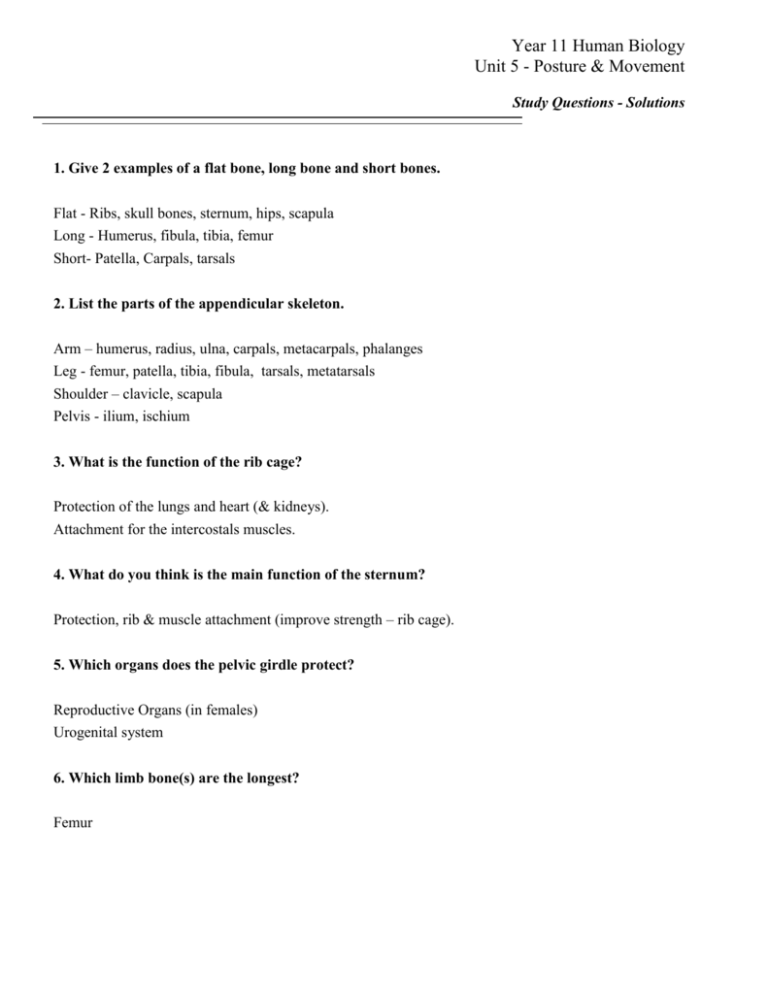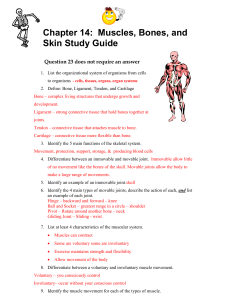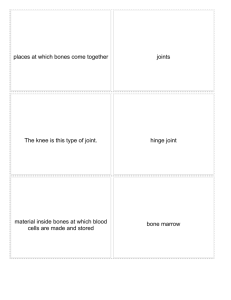Unit_5_Study_Questions_-_Solutions
advertisement

Year 11 Human Biology Unit 5 - Posture & Movement Study Questions - Solutions 1. Give 2 examples of a flat bone, long bone and short bones. Flat - Ribs, skull bones, sternum, hips, scapula Long - Humerus, fibula, tibia, femur Short- Patella, Carpals, tarsals 2. List the parts of the appendicular skeleton. Arm – humerus, radius, ulna, carpals, metacarpals, phalanges Leg - femur, patella, tibia, fibula, tarsals, metatarsals Shoulder – clavicle, scapula Pelvis - ilium, ischium 3. What is the function of the rib cage? Protection of the lungs and heart (& kidneys). Attachment for the intercostals muscles. 4. What do you think is the main function of the sternum? Protection, rib & muscle attachment (improve strength – rib cage). 5. Which organs does the pelvic girdle protect? Reproductive Organs (in females) Urogenital system 6. Which limb bone(s) are the longest? Femur 7. Which limb bones would you expect to be thicker, and why? Femur, due to weight bearing 8. Which parts of the skeleton form the axial skeleton? Spine, skull, rib cage 9. List the 5 functions of the skeleton. Support, movement, protection, storage, muscle attachment. 10. Explain the structure of a long bone. External: Comprises a shaft (diaphysis), 2 ends (epiphysis) with articular cartilage covering each epiphysis. Internal: The diaphysis contains yellow marrow with the sides made of compact bone (ie they’re hollow). The ends contain spongy (cancellous) bone and the epiphyseal line – the region form which your bone tissue grows. 11. Describe the structure of a typical vertebrae. A typical vertebrae has a centrum which bears most of the weight with a neural arch which contains the spinous and transverse processes. A central hole, the vertebral foramen runs through the middle. 12. Explain how bones undergo ossification.(bone formation) Steps: • • • • • • Cartilage undergoes calcification Cartilage cells die Calcified matrix begins to break down Osteoblasts invade matrix & lay down bone cells Capillaries invade with the osteoblasts Each osteoblasts surrounds itself with bone 13. Name the major types of joints. Immovable, Slightly movable, & fully movable. 14. Describe the 5 different types of synovial joints. • • • • • Ball & socket: full movement: Hip and shoulder Hinge joint: Adduction, abduction: Elbow, knee Pivot joints: Rotation: Head Gliding joints: Side to side, back & forth: Carpals & tarsals. Saddle joints: Side to side, back & forth: Thumb. 15. Using a specific example, explain the components of a synovial joint. • • • • • • • Capsule: Surrounds & encloses the joint. Membrane: Makes up the inner layer of the capsule. Secretes synovial fluid. Synovial Fluid: Lubricates the joint & removes micro-organisms & debris. Articular Cartilage: Covers the joint & allows for smooth movement. Articular Discs: Divides the capsule into halves & causes fluid to be directed to the area of greatest friction. Bursae: Little sacs of synovial fluid. Accessory Ligaments: Hold the bones together 16. What are muscles and what are they made of? Muscles are the movement tissue of the body and they are made of 2 proteins, action & myosin. 17. Describe the general microscopic structure of muscle tissue. The belly of the muscle ð muscle fibres ð myofibril ð Actin & myosin. The sacomere is the distance the Z Line. The I Band is the distance myosin filaments and the A Band is the distance of the Myosin filaments. 18. Using diagrams, describe one theory of muscle contraction. The sliding filament model expolains that the actin & myosin interlock and slide over each other. 19. What are the main sources of energy for muscle contraction? Carbohydrates, then fats & protein (Secondary) 20. Why do muscles work in antagonistic pairs? Give an example of two muscles working antagonistically. To give the full range of movement. Eg back & forth in the leg & arms. Examples are triceps / Biceps & hamstrings & quadriceps. 21. On a diagram, identify the position for each of the following muscles: Biceps - Front of arm Triceps - back of arm Gluteus - bum Hamstrings- back of femur Quadriceps - front of femur Sternocleiodmastiod - neck Achilles Tendon - from heel to calf Gastrocnemius - back of lower leg Abdominals - Lower stomach / chest Pectorals - chest Brachioradalis - inside of forearm Deltoids - near the shoulder 22. List the major function of each of the above. Its either extension, flexion, rotation, adduction or abduction or the bones they run along. 23. List the anatomical features that aid in erect posture. • • • • • • Centrally located foramen magnum Small & protruding jaw bone that allows for balance. S-Shaped curve brings vertebral column under the centre of the skull. Broad, shallow pelvis helps to keep the carrying angle enabling the weight to be kept close to the central axis of the body. Outer hinge of knee joint larger & stronger to take weight of body Longer legs than arms, contributes to low centre of gravity. 24. Explain how muscles move the bones. Muscles contract and cause the bone it is attached to move. 25. Explain how the muscle system helps support the body against gravity. By the partial contraction & relaxation of various muscles. (Muscle tone)







